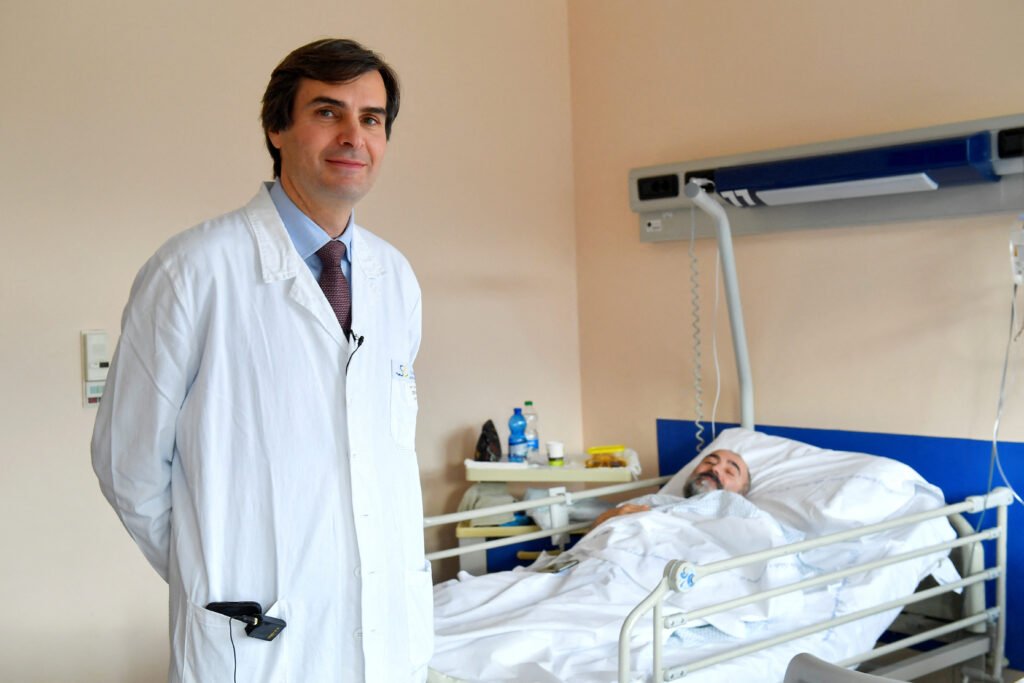In a groundbreaking development reported on December 27, doctors at Turin City Hospital (CTO) announced a revolutionary nerve transfer operation poised to restore hand functionality to a man previously paralyzed by a severe road accident. This pioneering surgical intervention holds the promise of not only transforming the life of the patient, Marcello Gaviglio, but also contributing significantly to the field of neuroscientific research and surgical innovation.
The surgical team at Turin City Hospital conducted a groundbreaking procedure by transferring a portion of Marcello Gaviglio’s sciatic nerve to his brachial plexus. The sciatic nerve, responsible for controlling the movement of his amputated foot, was redirected to the brachial plexus—a complex network of nerves linking the spinal cord to the shoulder, arm, and hand.
Paolo Titolo, one of the surgeons involved in this pioneering operation, underscored the significance of this milestone, stating that it marked the first instance of transferring a component of the sciatic nerve to the brachial plexus. Marcello Gaviglio, a 55-year-old healthcare worker, became a candidate for this groundbreaking surgery after undergoing the amputation of half of his left leg due to a motorbike collision five months ago.
Gaviglio suffered severe injuries to his brachial plexus and leg, leaving both hands unusable. The surgery, conducted on December 21, aimed to repurpose the sciatic nerve component that controlled Gaviglio’s left foot, rendering it surplus to requirements. By repositioning this nerve to the shoulder area, the surgical team aspired to potentially restore mobility to one of Gaviglio’s hands.
While nerve transfer surgeries have been performed in the past, the innovation in this case lies in the strategic relocation of a nerve traditionally associated with foot control to an area responsible for hand movement. Dr. Titolo emphasized the pioneering nature of the surgery, suggesting that its success could demonstrate the brain’s remarkable plasticity, showcasing its ability to control unexpected parts of the body and opening new avenues for neurological studies.
Marcello Gaviglio’s post-operative journey is critical in determining the success of this groundbreaking procedure. Presently, he remains unable to move his hand, and the anticipated timeline for assessing the outcome is approximately five months, during which he will undergo thorough post-operative care. The primary objective of the surgery is to restore “some grasp function” to Gaviglio’s hand, enabling assistance to the other hand in various daily activities.
This pioneering surgery, born out of four years of dedicated research, has been documented in the esteemed medical journal Injury. While Gaviglio recognizes the innovative nature of the surgery, his focus remains on the practical benefits, expressing a desire to collaborate with the skilled medical team and, ultimately, regain some degree of hand functionality.
Beyond the immediate impact on Gaviglio’s life, the success of this groundbreaking surgery holds broader implications for neuroscientific advancements. Dr. Paolo Titolo’s emphasis on the potential expansion of brain plasticity underscores the transformative possibilities that this procedure could unlock, offering insights into the brain’s adaptability to control unexpected regions of the body.
As Gaviglio embarks on the crucial post-operative phase, the medical community eagerly awaits the outcomes, recognizing the potential for a paradigm shift in nerve transfer procedures. The success of this innovative surgery could provide hope and a viable solution for individuals facing similar challenges, further advancing our understanding of the intricate capabilities of the human brain.
The meticulous documentation of this groundbreaking surgery in the medical journal Injury serves as a testament to the surgical team’s dedication and expertise. This documentation also stands as a valuable resource for future studies, enabling researchers and practitioners to draw upon the insights gained from Gaviglio’s case to refine and expand the applications of nerve transfer procedures.
Marcello Gaviglio’s journey is not only a testament to the collaborative efforts of medical professionals but also a reflection of the resilience exhibited by individuals facing adversity. The ongoing advancements in neurosurgery, exemplified by this case, contribute to the continuous evolution of medical possibilities, offering renewed hope for those in need of innovative solutions to complex health challenges.
In conclusion, the groundbreaking nerve transfer operation conducted at Turin City Hospital represents a significant stride in surgical innovation and neuroscientific understanding. Marcello Gaviglio’s experience not only holds personal significance but also contributes valuable insights to the broader field of medicine, setting a precedent for potential breakthroughs in the restoration of motor function through nerve transfer procedures.



